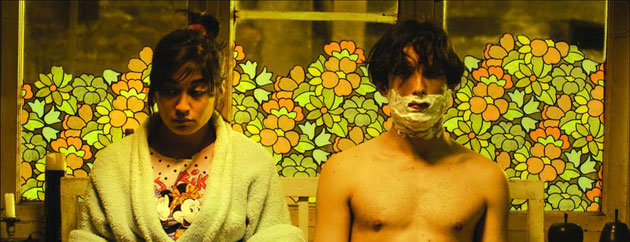
Bonsai
28 February, 2012“Fiction can take the shape of a lie, but also a narration, a forgery, a personal ritual or a pot containing and shaping a plant.” So says director Christian Jimenez about his cinematic adaption of Alejandro Zambra’s short novel Bonsai.
At its core, Bonsai, is a tale of life, growth and ideals and the varied ways in which both the films characters and we the audience, choose to assimilate the culture we consume, into our own lives.
Set in late 20th Century post-Pinochet Chile, the film focuses on an eight year period in the life of Julio (Diego Noguera) a slim, awkward, gawky young man, described by the director as a “South American Buster Keaton.” Julio’s words are kept to a minimum during portions of the film, provoking us to apportion the meanings of his pensive stares. We join Julio at the time of personal re-imagination and idiomatic rendering that is college. And it is against this backdrop of creative sprouting that we witness the burgeoning of Julio’s first love, with fellow literature student Emilia (Natalia Galgani). Their brief courtship and eventual intense love is berthed in pages of tales already told and articulated through words that are not their own, but are of those of the authors and ideals which they seek to connect with. Most prominently it’s the work of Marcel Proust. The title of the work, In Search of Lost Time, forms somewhat of a motif for the film, and it is over this work that the young couple share their first embrace.
Bonsai is a delicately constructed exploration of love, both platonic and romantic. In negating the simplistic, linear, romantic comedy incarnation, Jimenez does well to open a discursive space, which allows the viewer to perhaps recount tales of their own first loves detailed in poetry, prose or indeed in cinematography.
Bonsai maintains the chaptered structure of the short novel, flitting simultaneously between Julio’s first love Emilia and eight years into the future (the film’s present) where we meet a slightly more independent, shaggy bearded, Julio. By this time he is working as a literary assistant, and manages to find work digitally reproducing a handwritten novel for eminent author Gazmuri (Hugo Medina) who Julio initially is at odds with. When Julio questions Gazmuri for writing an entire novel by hand the author responds:
“Writing with the pencil you can feel the heart of the work… the rhythm between wrist and hand, not like a computer.”
However, Julio’s best laid plans go awry when he is undercut and loses the contract with Gazmuri, yet Julio maintains his boisterous neighbour-come-lover, Blanca (Trinidad Gonzalez). He is still working with Gazmuri, only to embark upon his own stuttered literary quest, positing his own words as those of Guzmuri, in detailing the circumstances of his first love, Emilia. Julio lovingly forges the new transcript, complete with coffee stains, crumbs and cigarette ash. This draws again on the Bonsai metaphor of the beauty being in the process, the craft, regardless of its stature or final standpoint.
Stylistic parallels can be drawn between Bonsai and Richard Ayoade’s Submarine: both use a neurotic and self-aware narration akin to the nervous chatter of some Woody Allen films. A technique that works well in giving a voice to the myriad of self-important musings which every intellect is capable of. As well as this, both films make dramatic use of not necessarily captivating backdrops, in order to highlight the oddity of the mundane.
In Bonsai Jiminez utilises a dusky palette of khaki, beige and grey to differentiate between Julio’s present day, and his college years where the hue is far more bright, green and vivid. In this respect the shifts in time are used to dramatic effect, to denote a loss of exuberance between Julio’s then and now, highlighting his shifting priorities and paradigms. Jimenez does well to makes use of a limited budget, and in not using any make up on set, utilises close shots for added texture and realism, that work well with an improvised and fairly sparse, minimalist soundtrack.
The regressions that we see Julio make in his current relationship with Blanca, are contrasted with the hope and passion which we saw as his relationship blossomed with Emilia, these dramatically ironic contrasts are maintained throughout.
The film, highlighted by the grand metaphor of Julio and Emilia’s Bonsai tree, although not necessarily original, is none the less effective. Shots of the young plant the couple care for together, later become macro shots of Julio preening, fabricating reinforcements and eventually repotting the tree. These coincide with the tender and warm close shots of Julio and Emilia completing a literary pilgrimage, reading out loud classical works of Latin American literature to each other, night after night, page by page, vowing to each other not to sleep apart until the task is complete.
Bonsai is a compact film that does not attempt to overstretch itself, nor involve itself — explicitly at least — in Chile’s peppered recent political past. Instead, it deals with some of life’s universals and what the director calls the important things:
“Love, lies, plants and literature.”
Bonsai is at selected UK cinemas from March 30th and is showing as part of ¡Viva! festival 2012 at Cornerhouse, Machester. See cornerhouse.org/viva2011 for screenings.
Follow Sounds and Colours: Facebook / Twitter / Instagram / Mixcloud / Soundcloud / Bandcamp
Subscribe to the Sounds and Colours Newsletter for regular updates, news and competitions bringing the best of Latin American culture direct to your Inbox.

